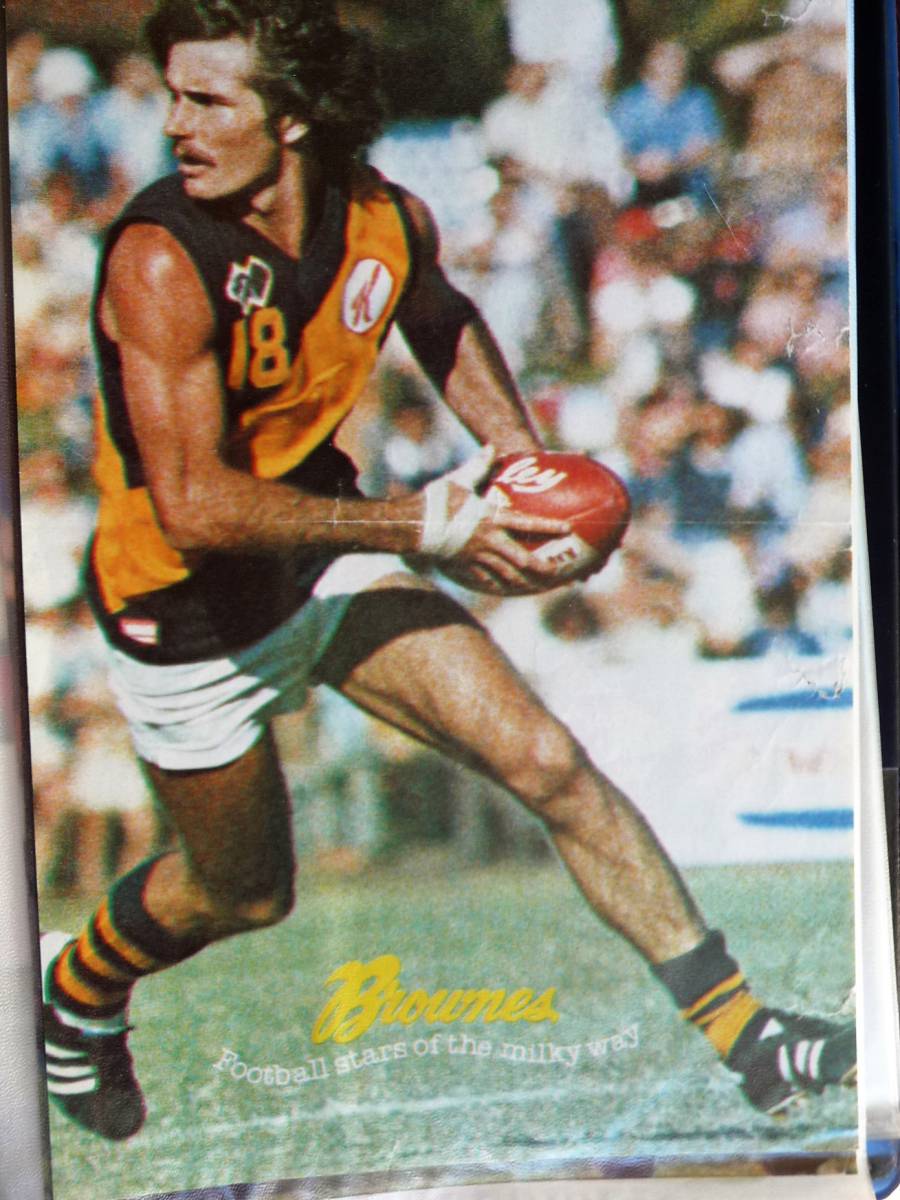
A Brownes Milk Photo from a series on WAFL players and an action shot of Hunter on 1980 Annual Report
Kenneth Ronald Hunter Born 28/ 04 /1957
Senior Clubs Claremont and carlton
Claremont Played 99 Games between 1975 and 1980
Carlton Played 147 Games between 1981 – 1989
Hall of fame Western Australian Football Hall Of Fame (2004)
Ken Hunter survived a gruelling induction into league football in Western Australia to become one of the most exhilarating and eye-catching performers in the game. After making four appearances in 1975 he became a Claremont regular the following year when he sustained a broken jaw on two separate occasions, two and a half months apart..
In 1977 he played outstanding football and was rewarded with selection in the Western Australian team to meet the VFL at Subiaco, in the last non-state of origin interstate match between the two sides. Starting on the bench, Hunter entered the fray in the third quarter, and moments later attempted to tackle Mark Maclure. His ‘reward’ for such impudence was yet another broken jaw – especially ironic this time in that Hunter and Maclure would go on to be teammates in a couple of VFL premierships.
Clearly, Hunter’s courage could not be doubted, but there were some who felt he was too frail to succeed at the highest level. Over the next three seasons, he proceeded to prove the doubters wrong, playing consistently well for a Claremont team that was just beginning to emerge from the doldrums, as well as for Western Australia in interstate matches. For three consecutive seasons from 1978 to 1980 Hunter finished runner-up to Graham Moss in Claremont’s best and fairest voting, while in both 1979 and 1980 he was accorded All Australian status.
By this time several VFL clubs were watching Hunter, particularly Richmond and Carlton, but it was the latter that recognised his true talents and recruited him to Melbourne in 1981, the Tigers believing him too frail for Victorian football. His 99 game WA(N)FL career was over, but he continued to produce excellent football in the VFL for the remainder of the decade as well as to make further state of origin appearances for Western Australia, for whom he ended up playing a total of 10 games.
From his first season in the VFL, Hunter established himself as one of the best defenders and most courageous players in the league. Indeed, those attributes were apparent from his VFL debut against, ironically enough, the reigning premiers Richmond, in the first round of 1981, when, alongside fellow Sandgroper debutant Peter Bosustow, he was best afield. It was no surprise then when he went on to win the club best and fairest in what was a Carlton premiership year.
The Blues followed with a back-to-back flag in 1982, and Hunter was again among the outstanding players of the season. In the Grand Final against Richmond, he was on the receiving end of a full-on shirtfront from Jim Jess, yet came back to play a solid game. It was just so typical of the way he played, as was exemplified in the return match against the Tigers the following year. Running back into an oncoming pack he twisted himself in the air to take one of the most courageous marks in the game’s history.
To allow him more freedom to roam, coach David Parkin started to give Hunter more roles forward and through the centre. He relished the new flexibility and became one of the finest utility players of the decade, collecting goals on a regular basis including several bags of seven and eight.
Toward the end of the eighties, injuries were taking their toll, however, and Hunter began to miss more games, although, for the most part, his form remained solid. Another premiership in 1987 proved the last great hurrah of his career, as in 1989 he was unable to recover from a hip operation and retired from the game, loved by Blues fans, and respected by all.
Author – John Devaney and Adam Cardosi

